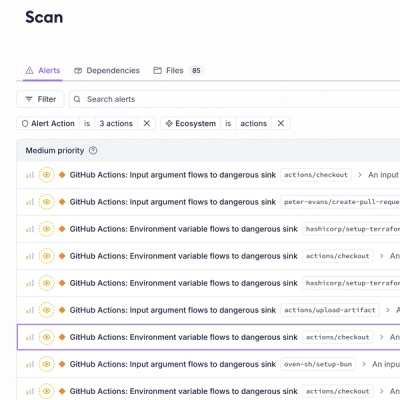
Product
Introducing Socket Firewall Enterprise: Flexible, Configurable Protection for Modern Package Ecosystems
Socket Firewall Enterprise is now available with flexible deployment, configurable policies, and expanded language support.
redux-jam is a framework for managing the complexity of multiple data
sources with different fetching and storage characteristics, while using
standard, flexible, and known systems, such as Redux.
Storing data fetched from a server locally is a very attractive method of improving user experience, but it comes with significant difficulties. Deciding when to invalidate a locally cached dataset, and how to combine remote and local data can be a source of immense complexity. This is especially true when building an application designed for offline capabilities.
npm install redux-jam
or
yarn add redux-jam
Add the JAM model reducer to your root reducer:
import {reducer as model} from 'redux-jam'
const rootReducer = combineReducers({
model,
...
})
export default rootReducer
Before data can be manipulated a schema describing the structure of the data must be defined. There are a number of ways to do it, the two most common are to define the data manually, or import it automatically using an external package.
Schemas are built using the Schema class:
import {Schema} from 'redux-jam'
let schema = new Schema()
To define models in a schema, use the merge method, which accepts an object
argument describing a part of a schema:
schema.merge({})
merge may be called any number of times. Each subsequent call will overwrite
any overlapping models.
The structure of the schema object is similar in some ways to the structure of a JSON-API object. Take for example the following definition of a movie:
{
movie: {
attributes: {
name: {
required: true
},
duration: {},
year: {}
},
relationships: {
actors: {
type: "person",
many: true,
relatedName: "actedIn"
}
}
api: {
list: () => {},
detail: () => {},
create: () => {},
update: () => {},
delete: () => {}
}
},
person: {
attributes: {
name: {
required: true
}
},
api: {
list: () => {},
detail: () => {},
create: () => {},
update: () => {},
delete: () => {}
}
}
}
This defines two models: movie and person. The api sections of each
model are placeholders for calls to API endpoints. They should return promises,
which in turn return JSON-API structured data.
Options for attributes are currently limited to required.
Options for relationships:
type
required
many
relatedName
If you're using Django and DRF, your schema can be loaded into JAM automatically, which is particularly convenient.
Refer to Django-JAM
Fetching data from the server is achieved with a higher order comonent,
withView. Views collect a set of one or more queries and provide the
resultant data to a React component.
The following snippet shows a React component that loads movies whose title contains the term "Rocky", and sorts them on year:
import React from 'react'
import {withView} from 'redux-jam'
import schema from 'models'
const view = schema.view({
name: 'movieList',
queries: {
movies: {
type: 'movie',
filter: F.contains('title', 'Rocky'),
sort: 'year'
}
}
})
@withView(view)
class MoviesList extends React.Component {
render() {
const {moviesList} = this.props
const {loading, queries} = moviesList
if (!loading) {
return (
<ul>
{queries.movies.map(m => <li>{m.title}</li>}
</ul>
)
}
else
return null
}
}
redux-jam provides a form like interface for mutating data.
import React from 'react'
import {withForm} from 'redux-jam'
import schema from 'models'
@withForm({type: 'movie'})
class MoviesList extends React.Component {
render() {
const {renderField} = this.props
// TODO
}
}
FAQs
A Redux JSON-API model layer.
We found that redux-jam demonstrated a not healthy version release cadence and project activity because the last version was released a year ago. It has 3 open source maintainers collaborating on the project.
Did you know?

Socket for GitHub automatically highlights issues in each pull request and monitors the health of all your open source dependencies. Discover the contents of your packages and block harmful activity before you install or update your dependencies.

Product
Socket Firewall Enterprise is now available with flexible deployment, configurable policies, and expanded language support.

Security News
Open source dashboard CNAPulse tracks CVE Numbering Authorities’ publishing activity, highlighting trends and transparency across the CVE ecosystem.

Product
Detect malware, unsafe data flows, and license issues in GitHub Actions with Socket’s new workflow scanning support.